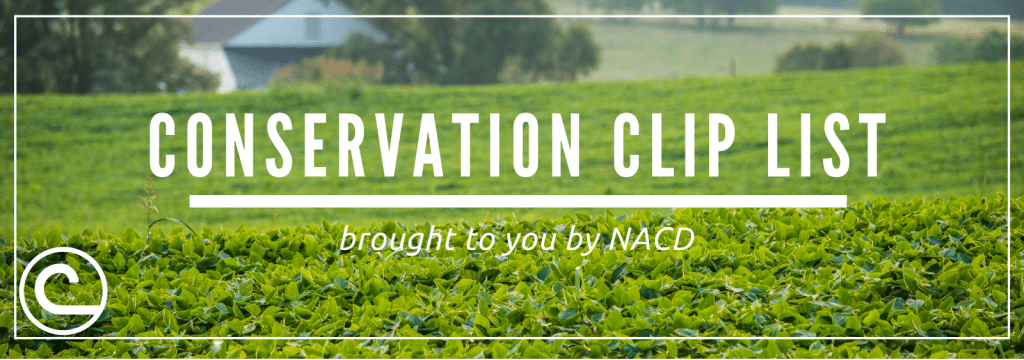
Conservation Clips is a weekly collection of articles distributed by NACD that provides our members and partners with the latest news in what’s driving conservation. These articles are not indicative of NACD policy and are the opinions of their authors, unless otherwise noted. If you have a relevant submission or need assistance with accessing articles, please contact NACD Communications Manager Sara Kangas.
NACD Blog: Workshops Improve Resource Professionals’ Outreach Efforts
09/17/18
The Sustaining Family Forests Initiative (SFFI)’s Tools for Engaging Landowners Effectively (TELE) program out of Yale School of Forestry & Environmental Studies is helping forestry agencies connect to private landowners through better outreach. SFFI-led workshops help resource professionals learn how to influence landowners to take steps to sustainably manage their lands.
NACD Blog: Waldo County Utilizes New Approach to Forest Resource Protection
09/17/18
The Waldo County Soil and Water Conservation District (SWCD) of MidCoast Maine has been working in partnership with local landowners to improve the health of regional forests. Maine has developed a new concept to address forest conservation and stewardship in its service area through a project called the Forests for Our Future (FFOF).
The Hill: Farm bill must protect working lands conservation programs
By Tim Walz
09/19/18
(Opinion) As my fellow farm bill conferees and I continue negotiations in the weeks ahead, we must ensure that a final farm bill strengthens working lands conservation programs. As we move forward with the conference process, I strongly support the Senate’s approach to working lands conservation and will continue to advocate for these provisions benefiting soil health, clean water, and the rural and urban communities my colleagues and I represent.
Lancaster Farming: Conservation District Heightens Cover Crop Reach
By Troy Bishopp
09/14/18
One of the biggest challenges of cover cropping is deciding whether to fit them into your current rotations, or to develop new rotations that take full advantage of their benefits. In the midst of solving this timing issue with traditional establishment of cover crops in this short window via broadcasting, drilling and aerial seeding, a new, specialized tool is taking flight. It comes in the form of a 12-foot tall, high clearance, or hi-boy, cover crop interseeder.
Agri-Pulse: Looming farm bill expiration yields uncertainty over funding
By Philip Brasher
09/19/18
The 2014 farm bill is set to expire in just over one week, raising concerns about disruptions in a number of programs, including one of the largest conservation programs. Congressional negotiators had hoped to reach agreement on a new farm bill in time to have it enacted by Sept. 30, when the 2014 law expires, but the talks remain bogged down this week over a range of policy and funding disagreements.
Ag Professional: ARA Releases Cover Crop Survey About Retailer Services
09/19/18
A new study found that 89 percent of agricultural retailers have offered cover crop products and services in the past two years, and 94 percent say they want to expand these offerings in the future.
The Guardian: Microplastics can spread via flying insects, research shows
By Damian Carrington
09/19/18
Microplastic can escape from polluted waters via flying insects, new research has revealed, contaminating new environments and threatening birds and other creatures that eat the insects.
Des Moines Register: Iowa View: Three things Iowa must do to protect from flooding
By Kamyar Enshayan
09/17/18
(Opinion) Manage the floodplains by giving more room to the rivers and streams of this beautiful state. Floodplains are not idle pieces of land sitting there waiting to be developed. They are treasures that offer vital ecosystem services, such as flood control, all for free.
Delta FarmPress: Conservation in the Farm Bill: Good for Farmers, Communities and Businesses
By Glenn Prickett and Tom Waldron
09/14/18
(Opinion) Simply put, the farm bill is the most important legislation for conserving private lands in the United States. Voluntary conservation programs in the bill promote healthier soil, cleaner water, enhanced wildlife habitat, increased flood control, and lowered risk of damage from natural disasters.
Farm Forum: Should buffer strips be mandatory in South Dakota?
By Bart Pfankuch
09/18/18
As South Dakota and most other states rely on voluntary efforts by farmers to treat pollution and limit runoff – historically with only limited success – a new regulatory approach in Minnesota is showing that mandating water protection methods can make a significant difference.
WBOI: Farmer Diligence May Be Preventing Algal Blooms In Indiana
By Rebecca Thiele
09/17/18
Indiana doesn’t get as much of its water from lakes and shallow reservoirs where algal blooms tend to form. But some of the state’s success could also be attributed to farmers who keep fertilizers and other nutrients from feeding algal blooms. McLain says that includes practices like cover cropping and no-till agriculture.